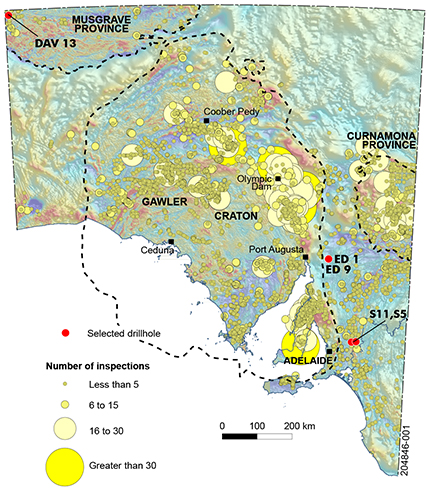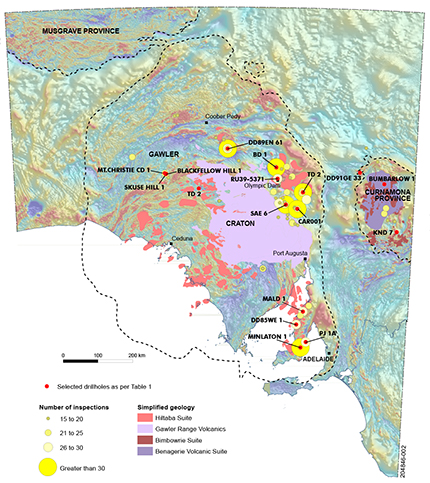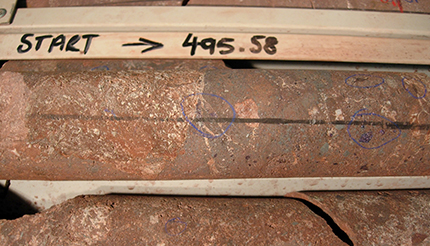Ursula Michael and Anthony J Reid
Geological Survey of South Australia, Department of State Development
Download this article as a PDF (1MB); cite as MESA Journal 82, pages 15–19
Introduction
At each stage of the mineral exploration process decisions need to be made on the cost versus benefit of continuing the exploration program. Government geological surveys play a role in reducing the risk of costly exploration by providing precompetitive geoscience data and information.
Drill core stored in a reference library is a critical element in precompetitive geoscience information held by government. By inspecting historical drill core, geologists can understand mineral textures and rock types intersected in previous drilling to better predict what might be intersected in their own exploration programs.
The South Australian Government has invested in a new Drill Core Reference Library, providing an improved facility with which to view the vast amount of core held in the collection (Cirson and Taylor 2014). We have investigated the drill core inspection and drillhole database (held by the Department of State Development) to understand patterns in core viewing for mineral exploration in South Australia. This article highlights some of the trends in this data and identifies the mineral drillholes that have been inspected most often.
Drillhole database
The SA Geodata database holds records for more than 250,000 drillholes completed during exploration for minerals, petroleum, geothermal and water in South Australia. Of these, samples from 38,713 are physically stored in the core library. SA Geodata stores information on drillhole location, drilling and operator metadata, and available geological logs, sampling and analytical data. The storage and inspection of drill core held by the library has been managed within a module of this database since 1994.
Analysis of core and cuttings samples is allowed. Non-destructive analysis methods are encouraged; however, destructive sampling may be permitted in some circumstances. Drill core held by the department remains the property of the state and it is a requirement that any new data generated as the result of access to samples is lodged with the department in a timely manner. This ensures information gathered from the drillhole is publicly available and held in perpetuity by the department for the benefit of future users.
Timely lodgement of data – geochemical, petrological, petrophysical etc. – should be a priority for all users of the library.
Drillhole inspections
Overview
Figure 1 Location map of all open file mineral drillholes in the South Australia Drill Core Reference Library, shown on state total magnetic intensity image.
The locations of all open file drillholes held in the South Australia Drill Core Reference Library are shown on Figure 1 and are colour coded by number of inspections following lodgement with the library. The 10 most inspected drillholes are listed in Table 1. Drillholes inspected >8 times occur across all of the major geological provinces within the state, but the majority of core inspections are for samples from the Gawler Craton and Curnamona Province. This reflects the perceived high prospectivity for minerals in these provinces, particularly for key commodities of copper, gold and iron ore. Drillholes with >8 inspections are also recorded for basins on the margins of the cratons that are prospective for coal and uranium, such as areas around Coober Pedy on the northern Gawler Craton (Fig. 1).
Outside the two major provinces, four drillholes have been inspected >8 times from the Neoproterozoic to Cambrian rocks of the Adelaide Rift Complex and the Kanmantoo Group. These are ED 1 and ED 9, inspected 9 and 12 times respectively, and S5 and S11, each inspected 12 times. ED 1 and ED 9 were drilled by Utah Development Co. in the search for stratabound copper mineralisation in the central Adelaide Rift Complex (Rowlands, Tedder and Jarvis 1977). S5 and S11 were drilled by North Broken Hill Ltd on Cu–Ni sulfide targets associated with mafic and ultramafic intrusives in the central Kanmantoo Group region (Hannigan et al. 1977).
One drillhole from the Musgrave Province has been inspected 13 times. This is diamond drillhole DAV 13, which was drilled by the department in 2002 into gabbro, pyroxenite and troctolite of the Giles Complex (Constable and Gum 2002). The samples show primary magmatic copper sulfide (chalcopyrite) within a magnetite-rich wehrlite portion of the layered intrusion, and the relatively high number of inspections reflect company interest in exploration for magmatic Cu–Ni sulfides across the Musgrave Province (Gum and Katona 2010).
| Number of inspections | Drillhole | SA Geodata drillhole number | Depth drilled (m) | Date drilled | Operator | Target commodity | SARIG reference | Comments |
|---|---|---|---|---|---|---|---|---|
| 56 | SAE 6 | 165609 | 1,200 | 31/08/89 | Carpentaria Exploration | Cu, Au | Env 06735 | Exploration for Olympic Dam style Cu–Au–U mineralisation; Emmie Bluff IOCG prospect. |
| 49 | CAR002 (PACE co-funded) | 205822 | 984 | 07/07/05 | RMG Services | Cu, Au+ | Env 11036 | Discovery drillhole for Carrapateena IOCG deposit. |
| 43 | DD86EN 25 | 141773 | 368 | 11/06/86 | Western Mining Corporation | Base metals, Au, U, Fe | Env 04248 | Exploration for Olympic Dam style Cu–Au–U mineralisation, along with metamorphic and hydrothermal breccia related iron ore in the Mount Woods region. |
| 34 | BD 1 | 18189 | 941 | 06/11/76 | Western Mining Corporation | Cu, U, Au | Env 08482 | Exploration for IOCG deposits in the region around Olympic Dam. |
| 34 | TD 2 | 25384 | 881 | 16/12/81 | Western Mining Corporation | Cu, U, Au | Env 08482 | Exploration for IOCG deposits in the region around Olympic Dam. |
| 33 | MINLATON 1 | 21704 | 994 | 31/07/56 | South Australia Department of Mines | Base metals, Cu, Au | Env 00619 (logs); RB 71/00120 (geochemistry) | Stratigraphic drillhole. |
| 30 | DD85WE 1 | 139489 | 155 | 02/08/85 | CRA Exploration | Cu, U, Au | Env 04214 | Exploration for base metals on the Yorke Peninsula, south of Wallaroo, west of Maitland. |
| 29 | MALD 1 | 192428 | 363 | 10/12/93 | Mount Isa Mines | Base metals, Au, Ag | Env 08029 | Exploration for base metals on the Yorke Peninsula. |
| 27 | RU39-5371 | 218473 | 300 | 25/09/03 | Western Mining Corporation | Cu, Au, Ag, U | Not available | Underground drillhole from within the Olympic Dam IOCG–Ag–U deposit. |
| 27 | PJ 1A | 143968 | 291 | 30/03/84 | BHP Minerals | Base metals, Cu, Au | Env 03567 | Exploration for base metals on the Yorke Peninsula in the vicinity of the historical Hillside copper workings, Port Julia. |
| 27 | DD89EN 61 | 141785 | 480 | 21/11/89 | CRA Exploration | Cu, Au | Env 04248 | Exploration for Olympic Dam style Cu–Au–U mineralisation, along with metamorphic and hydrothermal breccia related iron ore in the Mount Woods region. |
High-demand drillholes, exploration focus and the role of government drilling initiatives
Figure 2 Open file mineral drillholes inspected >15 times, showing prospective/selected geological units and state total magnetic intensity image. Drillholes mentioned in text are labelled.
Drillholes in high demand (>15 inspections) are shown in Figure 2. This highlights the high level of interest on the eastern Gawler Craton. The region is highly prospective for iron oxide – copper–gold (IOCG) mineralisation within the Olympic Cu–Au Province (Skirrow et al. 2007). The majority of drill core inspections within the Olympic Cu–Au Province are from the region around Olympic Dam, including RU39-5371 from the Olympic Dam deposit itself (Fig. 2). These include drillholes BD 1, TD 2, SAE 6 and CAR002 (Fig. 3), the latter being the PACE co-funded discovery hole of the Carrapateena deposit. This region is dominated by hematite-rich breccia-style Cu–Au (±U) mineralisation. Many holes have also been inspected from the southern portion of the Olympic Cu–Au Province on the Yorke Peninsula (Minlaton 1, PJ1A, MALD 1), and from regions to the north of Prominent Hill Cu–Au mine, in the area of Mount Woods (DD86EN 25, DD85WE 1, DD89EN 61; Fig. 2).
In the Yorke Peninsula region, Cu–Au mineralisation formed at deeper crustal levels than the hematite-breccia systems of the Olympic Dam region, as exemplified by the Moonta–Wallaroo mining district and the Hillside deposit (Conor et al. 2010). Likewise, in the Mount Woods region, deposits such as Peculiar Knob or Cairn Hill also represent iron-dominated alteration systems formed at deep crustal levels (Davies 2000). Given the regional variations in mineralisation style, mineral exploration in various regions of the Olympic Cu–Au Province will require some refinements to the exploration approach. The choice of effective exploration methods will be assisted by reference to the most appropriate samples held in the drill core reference collection.
The demand for drillhole sample inspections for the Curnamona Province is from across the province and highlights the diversity of mineral systems in the region. Drillholes with a high number of requests from the southern region include KND 7 drilled by Havilah Resources NL in 1988 on stratabound Cu–Au mineralisation in the Kalkaroo deposit (Hayward et al. 2000). Bumbarlow 1, drilled into the central portion of the Curnamona Province by the department, has been inspected 20 times. This was drilled to test the petroleum potential of the Cambrian section in the central part of the eastern Arrowie Basin (Youngs 1977), but revealed instead the upper portions of the sedimentary and volcanic successions associated with the Benagerie Volcanic Suite. In the northern Curnamona Province, within the Mount Painter Inlier, CRA Exploration Pty Ltd drillhole DD91GE 33 has been inspected 18 times. This cored hole penetrating the hematite–quartz breccia of the Mount Gee Sinter (Hughes, Louwrens and Newell 1994) is a unique representation of the uranium mineralisation within the Mount Painter Inlier. Repeat inspections of cores from widely dispersed regions reveal sustained interest in the diverse geology and mineralisation of the Curnamona Province.
Core sample from the PACE co-funded discovery hole of the Carrapateena deposit, CAR002, showing bornite mineralisation in hematite breccia. (Photo 401840)
A final observation from this dataset derives from drillholes inspected in the regions of the northwestern Gawler Craton (Fig. 2). Despite containing the Challenger gold mine (Poustie, Bamford and Daly 2002) and gold deposits of the Central Gawler Gold Province such as Tarcoola and Tunkillia (Ferris and Schwarz 2003), this region remains a greenfield exploration region with potential for deposit styles as varied as intrusion-related gold, orogenic gold and Ni–Cu sulfides associated with mafic and ultramafic intrusions (Constable, Fairclough and Gum 2005; Daly, Fanning and Fairclough 1998; Daly and van der Stelt 1992; Ferris and Schwarz 2003). In this region, drillholes that have been inspected >15 times are dominated by the cluster of holes in the vicinity of Mount Christie (Fig. 2). These holes, including Mount Christie CD 1, Blackfellow Hill 1 and Skuse Hill 2, were all drilled by the department as part of regional stratigraphic drilling programs investigating the iron ore potential and also the composition and mineral potential of mafic intrusive rocks in the region (Daly and van der Stelt 1992; Whitten 1965). The repeat requests for inspections of these cores underscores the value of regional stratigraphic drilling programs in greenfield regions. In general, exploration risk is reduced by the availability of data and samples from previous drilling; nowhere is this more significant than in greenfield regions such as the western Gawler Craton.
Conclusion
The South Australia Drill Core Reference Library contains samples from 38,713 open file drillholes that are available for inspection. These drillholes provide an invaluable record of exploration activity and government geoscience initiatives. Interrogation of the drillhole database focusing on the number of times individual drillholes have been inspected provides some indication of mineral exploration company priorities and how they perceive the prospective geology and mineral potential of South Australia. The results indicate:
- A major focus for mineral exploration continues to be the eastern Gawler Craton, in particular the region around Olympic Dam.
- Each of the major crystalline basement regions of the state has received some level of exploration interest as measured by the frequency of drillhole inspections. Lower levels of requests for samples from the Musgrave Province and Adelaide Rift Complex – Kanmantoo Group possibly relate to perceived difficulties in access for exploration or reflect extensive natural outcrop that is accessible to surface mapping, rather than simply a perception of lower mineral potential.
- Copper has been the major commodity focus behind drillhole inspections. Other commodities with high level of interest include gold, uranium, iron and nickel.
- Holes drilled by the government, particularly in greenfield regions, show high levels of inspection that confirm their usefulness as important records of the geology and mineral potential (e.g. cored deep holes in the northwestern Gawler Craton).
Ongoing inspections of the drillhole samples stored in the new South Australia Drill Core Reference Library will undoubtedly continue to assist companies to refine their exploration strategies and to develop new insights into the geological evolution and mineral potential of South Australia that are crucial to future mineral discoveries.
References
Conor CHH, Raymond O, Baker T, Teale G, Say P and Lowe G 2010. Alteration and mineralisation in the Moonta-Wallaroo copper-gold mining field region, Olympic Domain, South Australia. In TM Porter ed., Hydrothermal iron oxide copper-gold and related deposits: a global perspective, Vol. 3. PGC Publishing, Adelaide, pp. 147–170.
Daly SJ, Fanning CM and Fairclough MC 1998. Tectonic evolution and exploration potential of the Gawler Craton, South Australia. AGSO Journal of Australian Geology & Geophysics 17:145–168.
Skirrow RG, Bastrakov EN, Barovich K, Fraser GL, Creaser RA, Fanning CM, Raymond OL and Davidson GJ 2007. Timing of iron oxide Cu-Au-(U) hydrothermal activity and Nd isotope constraints on metal sources in the Gawler Craton, South Australia. Economic Geology 102(8):1441–1470.





